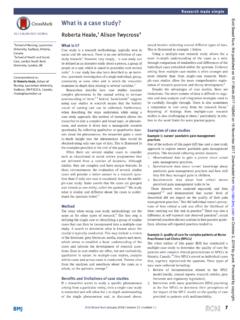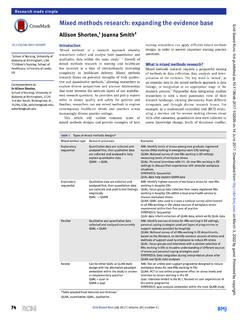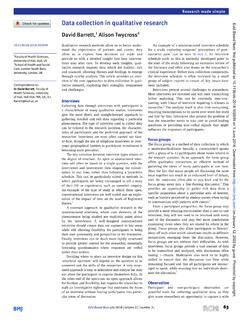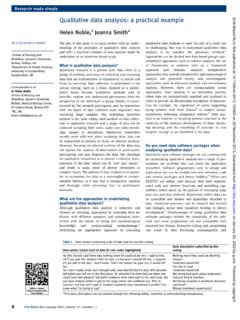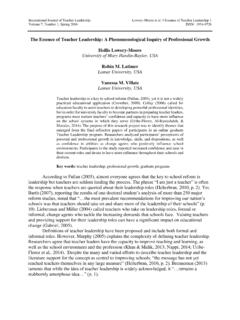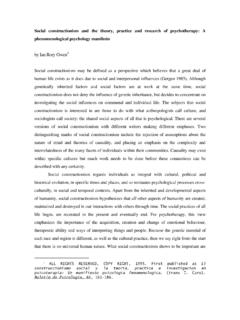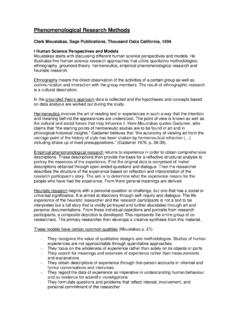Transcription of Interpretive phenomenological analysis applied to ...
1 Evid Based Nurs January 2019 | volume 22 | number 1 | 7 School of Healthcare, University of Leeds, Leeds, UKCorrespondence to: George Peat, School of Healthcare, University of Leeds, Leeds LS2 9JT, UK; hcgwp@ leeds. ac. ukInterpretive phenomenological analysis applied to healthcare researchGeorge Peat, Alison Rodriguez, Joanna SmithResearch made the last Research Made Simple Series article, we briefly outlined the main phenomenological research approaches in relation to investigating healthcare phenomena including Interpretative phenomenological analysis (IPA). IPA was originally developed as a method to undertake experiential research in psychology1 and has gained prominence across health and social sciences as a way to understand and interpret topics which are complex and emotionally laden, such as illness In this article, we detail in more depth, the philo-sophical and methodological nuances of IPA.
2 Overview of IPAThe aim of IPA is to uncover what a lived experience means to the individual through a process of in depth reflective IPA draws on phenomenological thinking, with the purpose to return to the things them-selves (p 168).4 However, IPA also acknowledges that we are each influenced by the worlds in which we live in and the experiences we encounter. Therefore, IPA is an interpretative process between the researcher and researched, influenced predominantly by Heidegger s Interpretive phenomenology, hermeneutics and idiog-raphy,2 3 summarised in table is particularly useful for understanding under researched phenomena or perspectives.
3 Unlike other phenomenological research approaches, IPA offers direc-tion on how to approach a phenomena of interest with guidance for sampling, data collection and analysis . Table 2 details the prescriptive methods of role of the researcher in IPAThe phenomenological and hermeneutic tenets of IPA (table 1), position the researcher as an integral part of the research process (table 2). While IPA researchers view the participant as the experiential expert, they acknowledge that experience cannot be simply Rather, a process of rich engagement and interpreta-tion involving both the researcher and researched is required. This engagement is commonly referred to as the double hermeneutic approach to analysis , whereby the researcher seeks to make sense of the participant(s) making sense of their world(s).
4 5 To assist this mean-ing-making process, IPA calls on researchers to engage with what is known as the hermeneutic circle (figure 1). The hermeneutic circle can be thought of as an iterative process involving a moving between the smaller units of meaning and the larger units of meaning, or between the parts and the whole of the investigated phenomena or lived the researcher s prior conceptions interact with new experiential encounters is of significance to IPA. Heidegger emphasised that rather than bracketing our prior conceptions prior to engaging with participants and Table 1 Philosophical influences underpinning Interpretative phenomenological analysis (IPA)InfluencePhenomenologyHermeneuticsI diographyDescriptiveInterpretivePurposeD escribe the lived experience without assigning and interpret the meaning of the lived guide the interpretation of the text of individual and value the perspectives of individuals in Scholars and influencesHusserl: put to one side preconceived judgements, known as the epoch or bracketing , in order to better appreciate the experienced : we as researchers are part of the.
5 Interpretation comes from our own perspective/being in the : we are always in a state of : understanding involves grammatical and psychological : recognises that researchers have preconceived ideas and experiences that they bring to the : meaning making is a fusion of participant and researcher to IPA1. Ongoing reflecting on the phenomenon itself rather than exploring how experiences can fit with predefined Bracketing, where each previous case is put to one side before the researcher moves on to read and analyse the next The interpretation of an individual s meaning making is considered in light of the researcher s perspective, at that Researchers observe and empathise but view phenomena from their own perspective or being in the world; the researcher cannot fully share the experiences of The narrative is developed through Interpretation becomes an art.
6 Through detailed and meaningful analysis participants accounts can be appreciated providing insights into their lived Making sense of what has been shared involves close engagement with the data, but interpretation can only occur in light of our own experiences, therefore a cyclic approach to bracketing is The researcher cannot be separated from the researched, engaging with a world transforms the researcher in some Case by case, systematic analysis . on January 24, 2022 by guest. Protected by Based Nurs: first published as on 1 December 2018. Downloaded from Evid Based Nurs January 2019 | volume 22 | number 1 | 8 Research made simplethe data, we should acknowledge how they consistently reveal themselves throughout the research Therefore, an IPA researcher needs to be mindful of their own beliefs, perceptions and experiences so that they can enrich their interpretations rather than them being an obstacle to making sense of the participant s expe-riences.
7 This is achieved through the art of is the process of being aware and bringing to light how the researcher influences the research A range of reflexive practices exist for different methodological IPA draws on inter-subjective reflexivity, an approach that aims to unravel the dynamic that exist within the researcher partici-pant The double hermeneutic dynamic central to IPA is also of relevance when considering the beliefs, thoughts and attitudes that may interplay between the researcher and researched. For example, commonalities and disparities between the participant/s and researcher may reveal themselves as the experien-tial account is explored and subsequently influence the analysis of the account/s.
8 Likewise, pre-existing roles may influence perceptions, particularly if participant/s and researcher were familiar with one another prior to engaging in research activity. This can be particularly relevant if the researcher has a dual role of researcher and health Engaging in the art of reflex-Table 2 Methods associated with interpretative phenomenological analysis (IPA)MethodsApplication to IPAS ample and recruiting participantsIPA focuses on small and homogeneous samples; the research question being addressed must be meaningful to participants who are purposively selected because they have experience of the number of participants in IPA studies is small (typically less than 10)
9 To enable a detailed microlevel analysis of the participants participant offers a rich reflective account of their experience/s and represent their own of generalisability are a contradiction in IPA because participants are recruited for their individual experience/s and perspective/s, rather than to represent perceptions of a wider collectionIPA has been undertaken using numerous qualitative data collection techniques that allow the participant to provide a rich account of their personal and lived experience including written accounts such as paper and online diaries, interviewing and focus , the in-depth semistructured interview is typically used to collect data in aim of the interview in IPA is to facilitate participants to share the experiences that are important to them, while an interview topic guide may be used the participant leads the direction of the interview.
10 The researcher s role in the interview is to guide the discussion in a way that focuses on the lived experience of the phenomena of analysisAnalysis begins with the close examination of the first case, leading to the development of case themes and then consideration of themes across the data set. IPA analysis involves a step-by-step approach3 4:1. Reading and rereading: the researcher immerses themselves in the data or transcript of a single Initial noting: as the researcher reads the case, observations are recorded which are often noted in the margin of the Developing emergent themes: the researcher chunks data relating to the observational notes of the Searching for connections across emergent themes: the researcher clusters the chunks of data and notes together and considers how they Moving to the next case.

